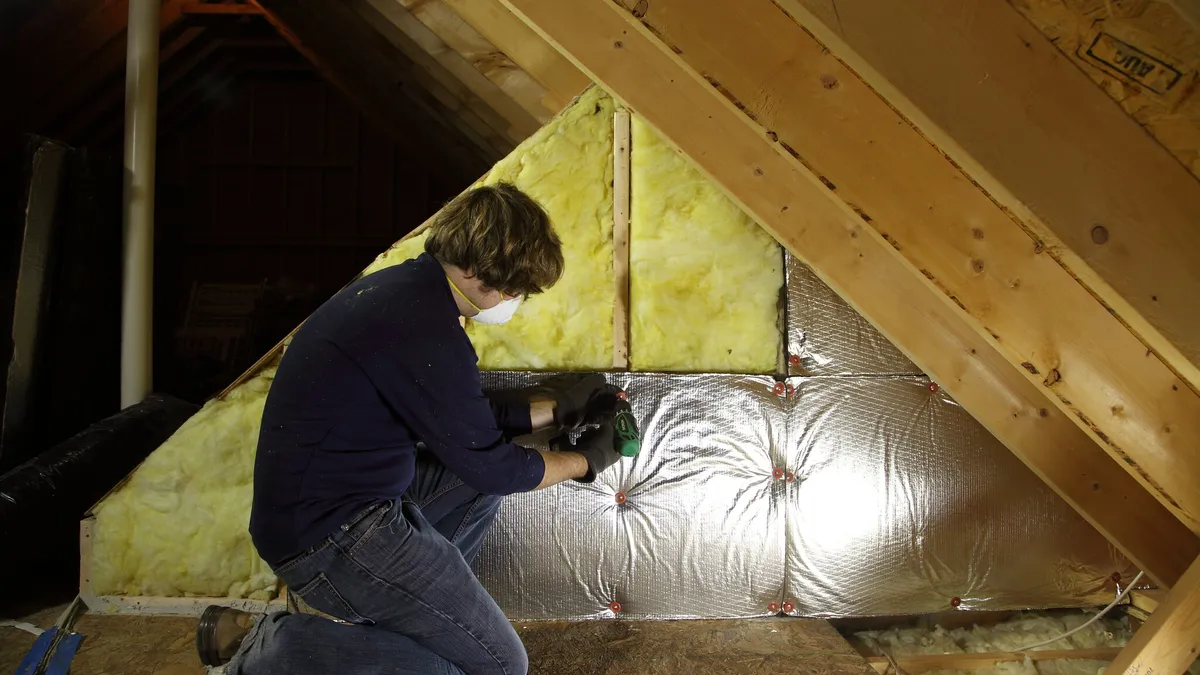Dive Brief:
- The energy efficiency sector continues to feel the impacts of the COVID-19 pandemic, with about a quarter-million contractors and others in the industry still out of work, but states are taking steps to bolster conservation programs and investments to aid in recovery, according to a new report from the American Council for an Energy-Efficient Economy (ACEEE).
- A dozen states in 2021 passed new clean energy legislation, including incentives for fuel switching and electrification, or set new appliance efficiency standards, the report notes. Those efforts will get a boost from the $1.2 trillion infrastructure bill signed by President Joe Biden in November, offering states "unprecedented levels of federal support."
- The pandemic has had "lingering disruptions" on the industry, according to ACEEE, and slowed the progress of energy savings programs broadly. The most recent data shows power saved by ratepayer-funded electric efficiency programs dipped 1.1% nationwide in 2020.
Dive Insight:
States in 2021 passed "ambitious" clean energy legislation to electrify buildings, promote cleaner heating systems, strengthen building codes, and shift to electric vehicles — all moves that will combat climate change while also helping to repair the economy, according to ACEEE.
“As states emerged from the early months of the pandemic, they turned to electrification and energy-saving standards to help address the growing urgency of the climate crisis,” ACEEE senior researcher and report author Weston Berg said in a statement.
There is room to make up. Ratepayer-funded efficiency program savings declined from 26.9 million MWh in 2019 to 26.6 million MWh in 2020. The decrease "reflects the significant disruptions to the energy efficiency industry from the pandemic," according to the report.
The report is an "interim update" to ACEEE’s typically annual state efficiency scorecard, which ranks policy and program efforts to conserve energy. The group said it "decided to forgo a formal scorecard ranking" due to COVID-19 and its impact on energy efficiency last year.
California topped the 2020 rankings, followed by Massachusetts, Vermont, Rhode Island and New York. Several of those states have taken additional steps to cut energy use and reduce greenhouse gas emissions, according to the new report.
In New York, the state is ramping up efficiency and building electrification programs to meet a 185 TBtu savings goal for 2025, Berg said in an email. And those programs are being designed to ensure at least 35% of benefits — with a goal of 40% — flow into disadvantaged communities.
And the New York State Energy Research and Development Authority has set aside more than $230 million for workforce training, heat pump initiatives for low- and middle-income customers, and other conservation programs.
Massachusetts, along with Rhode Island, Maine, Nevada, Oregon and the District of Columbia, passed laws in 2021 to require energy and water use reductions from several types of appliances.
More than a half dozen states passed new energy laws that set electrification as a "growing priority," according to the report. They are Massachusetts, Illinois, Colorado, Minnesota, North Carolina, Oregon and Washington.
California and New York set goals for the sale of all new passenger cars and light-duty trucks to be zero-emission by 2035.
New Jersey "marked a major milestone" in June when it finalized new utility energy efficiency programs, Berg said. Those programs are expected to invest at least $1.6 billion over the next three years, he said, driven by the state's 2018 clean energy law and a "landmark" 2020 Board of Public Utilities order that set annual gas and electricity savings targets.
The increased focus on efficiency will help address employment in the sector, experts say, which remains below pre-COVID levels.
Data from BW Research and E4theFuture, released in July, showed an 11% decline in employment in the efficiency sector, relative to pre-COVID-19 levels, with about 263,500 energy efficiency employees still out of work.
Federal funds could help close the gap, according to ACEEE. The infrastructure legislation passed last year includes $3.5 billion for low-income home weatherization, more than $1 billion for building energy codes, $7.5 billion for electric vehicle chargers, revolving loan funds for commercial building and home upgrades, and other programs.
There is also the potential for additional support from Congress. Biden's agenda includes another $1.8 trillion in potent climate and social spending, but the report notes its future is "uncertain amid ongoing negotiations in January 2022."














